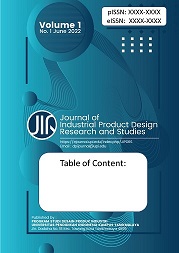A Case Study on Behavior of Performing Art Appreciators in Public Space: Indonesian Puppet (Wayang) Performance Arts and Video Mapping
Abstract
Keywords
Full Text:
PDFReferences
Adliyani, Z. O. N. (2015). Pengaruh perilaku individu terhadap hidup sehat. Jurnal Majority, 4(7), 109-114.
Anggoro, B. (2018). “Wayang dan seni pertunjukan” kajian sejarah perkembangan seni wayang di tanah Jawa sebagai seni pertunjukan dan dakwah. JUSPI (Jurnal Sejarah Peradaban Islam), 2(2), 122-133.
Awalin, F. R. N. (2018). Sejarah perkembangan dan perubahan fungsi wayang dalam masyarakat. kebudayaan, 13(1), 77-89.
Chua, S. P. (1993). Southeast Asian performing arts: Issues of cultural identity. SPAFA Journal (Old series 1991-2013), 3(2), 29-30.
Ekim, B. (2011). A video mapping conceptual design and application: Yekpare. The Turkish Online Journal of Design, Art and Communication, 1(1), 10-19.
Harnish, D. (2003). Worlds of wayang sasak: music, performance, and negotiations of religion and modernity. Asian Music, 34(2), 91-120.
Foley, K. (2015). The ronggeng, the wayang, the wali, and islam: Female or transvestite male dancers-singers-performers and evolving Islam in West Java. Asian Theatre Journal, 32(2), 356-386.
Lanjari, R. (2016). Political practice and its implication on folk art marginalization (case study of wayang orang/human puppet ngesti pandhowo). Harmonia: Journal of Arts Research and Education, 16(2), 163-171.
Mafra, R., Riduan, R., Zahra, S. A., Bahtiar, M. A., and Romdani, R. (2020). Perilaku pengguna toilet umum. Jurnal Arsir, 4(1), 52-63.
Mostafa, R. B., Lages, C. R., Shabbir, H. A., and Thwaites, D. (2015). Corporate image: A service recovery perspective. Journal of Service Research, 18(4), 468-483.
Nurullita, H. (2016). Stigmatisasi terhadap tiga jenis seni pertunjukan di Banyuwangi: Dari kreativitas budaya ke politik. Jurnal Kajian Seni, 2(1), 35-51.
Pandin, M. G. R. (2020). Moral-ethics-belief values towards Indonesian puppet (wayang kulit) performance arts. Utopia y Praxis Latinoamericana, 25(1), 515-521.
Riyanto, B., and Mataram, S. (2018). Perkembangan wayang kulit alternatif di bawah hegemoni wayang kulit purwa. Tahap, 28(1), 1-15.
Saidi, A. I., and Budiwaspada, A. E. (2015). Visualisasi dan transformasi kebertubuhan dalam film animasi planes (ke arah pembentukan mitos baru). Jurnal Panggung, 25(4), 327-342.
Septiawan, FD (2022). Perkembangan sejarah Kota Jakarta setelah Indonesia merdeka. HEURISTIKA: Jurnal Pendidikan Sejarah 2(2), 104-109.
Stenberg, J. (2015). Wayang potehi: Glove puppets in the expression of Sino-Indonesian identity. Journal of Southeast Asian Studies, 46(3), 391-416.
Wicaksono, A. (2012). Drama sebagai media transformatif penyampaian pesan sosial dalam pertunjukan wayang orang. Jurnal Seni Masyarakat Perkotaan, 12 (2), 77-90.
DOI: https://doi.org/10.17509/jipdrs.v1i2.53657
Refbacks
- There are currently no refbacks.
Copyright (c) 2023 Universitas Pendidikan Indonesia (UPI)

This work is licensed under a Creative Commons Attribution-ShareAlike 4.0 International License.

This work is licensed under a Creative Commons Attribution-ShareAlike 4.0 International License.


